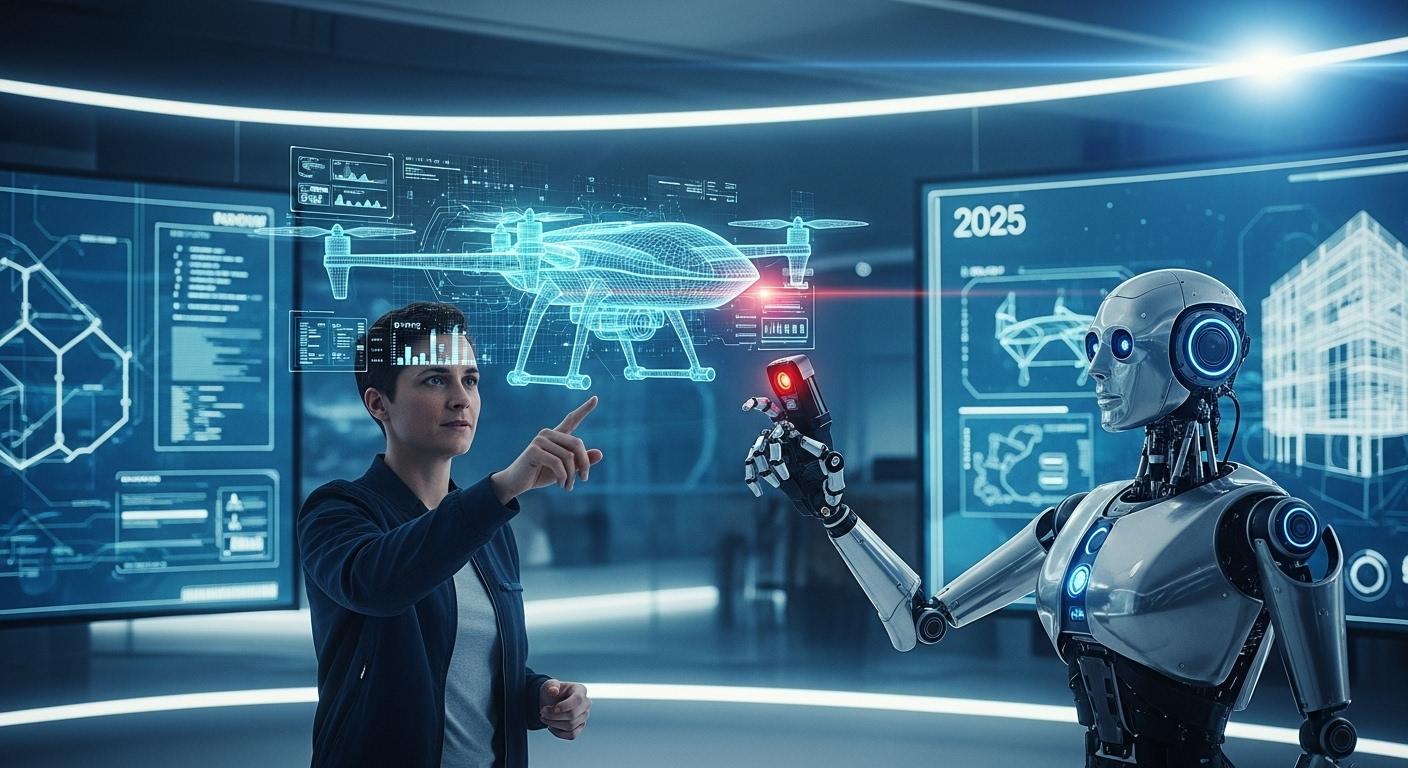
The future of product creation is shaped by powerful ai design trends. These key design trends for 2025 signal a major shift. AI empowers greater innovation. The boundary between a professional designer and an engaged consumer blurs. This evolution in design is powered by ai-driven co-design platforms, where ai is a core partner.
Key 2025 Trends for Innovation
- Hyper-Personalization at Scale
- Generative AI for Instant Prototyping
- Predictive Analytics
- Immersive Co-Creation
- Ethical AI
The Rise of AI-Driven Co-Design Platforms
AI-driven co-design platforms are changing digital product design. These tools move beyond basic customization. They create deeply personalized user experiences. This marks a significant evolution in key ai design trends. The platform becomes a partner. It helps creators and consumers build products together. Two major trends driving this shift are hyper-personalization and real-time adaptation.
Hyper-Personalization at Scale
Hyper-personalization is no longer a luxury. It is a core expectation. AI makes mass customization possible for every user. AI systems analyze user data to offer unique solutions. This level of personalization builds trust and boosts sales. Top brands already use this strategy effectively.
| Company | AI Solution | Results |
|---|---|---|
| L’Oréal | ModiFace offers virtual try-ons and personalized skin diagnostics. | 3x higher conversion rates and over 20 million diagnostics. |
| Nike | Predictive AI delivers ultra-personalized product recommendations. | A surge in engagement and repeat purchases. |
| Starbucks | “Deep Brew” AI suggests orders based on past habits and weather. | Higher order frequency and customer spend. |
The impact of this design approach is clear. Effective personalization creates powerful business outcomes.
- Companies excelling in personalization generate 40% more revenue.
- 80% of consumers are more likely to buy from a brand offering personalized experiences.
- AI-driven personalization can reduce customer churn rates by 28%.
Real-Time Feature Adaptation
The best ai design trends make digital products feel alive. Real-time feature adaptation is one of these trends. AI adjusts a product’s features instantly based on user behavior. The design responds to a user's needs in the moment. For example, AI tools like FlowForma can automate data extraction or help users map workflows using simple language. This makes complex tasks in digital product design much easier.
This AI capability directly improves engagement. A website can trigger a help chat if a user seems stuck on a sizing chart. It might offer a small discount if it detects hesitation before a purchase. This immediate, relevant assistance builds trust and keeps users on the page.
This dynamic interaction is central to ai-driven co-design platforms. The AI learns from every click and interaction. It helps refine the product during the design process itself. This creates a more intuitive and successful final product. These ai design trends are shaping the future of digital creation.
Generative AI for Instant Prototyping

Generative AI is one of the most transformative ai design trends for 2025. It dramatically shortens the path from idea to a tangible product. This technology allows both designers and consumers to create visual concepts almost instantly. The process of generative design accelerates innovation by making prototyping faster and more accessible. These ai design trends are changing how teams approach digital creation.
From Text Prompt to Concept
The era of complex design software as the only starting point is ending. Now, anyone can use natural language to create. A user simply types a text prompt, like a sleek, ergonomic office chair in blue fabric. The ai then generates multiple visual concepts in seconds. This capability is powered by advanced models like Generative Adversarial Networks (GANs). GANs use two neural networks:
- A Generator creates new design images.
- A Discriminator checks if the images look real or fake.
The generator constantly tries to fool the discriminator. This competitive process pushes the ai to produce novel and high-quality design options. It is a key part of the new generative design trends.
Instant Prototyping with Generative AI
This rapid concept creation leads to instant digital prototyping. What once took days now takes minutes. This is one of the most impactful ai design trends. AI-driven tools are not just utilities; they are collaborative partners. For example, Adobe Sensei integrates into creative workflows. It automates tasks like asset tagging and content analysis. This frees up designers to focus on refinement and strategy. The efficiency gains from generative ai are massive.
AI can reduce software development time by 30-50%. Teams using specific ai tools report cutting wireframing time by 90%. This allows companies to test ideas and respond to market trends faster than ever before.
These ai design trends empower a more dynamic and efficient design ecosystem.
Predictive Analytics: Key AI Design Trends
Predictive analytics is one of the most powerful ai design trends. It allows companies to look into the future. This technology uses data to forecast a product's potential success before it is even built. Instead of guessing, designers can make choices based on solid evidence. This approach reduces risk and increases the chances of creating a hit product. These ai design trends are changing how businesses approach innovation.
Forecasting a Design's Success
Companies now use ai to predict market trends and consumer needs. This helps them create products people will love. For example, PepsiCo used machine learning to analyze consumer data. This ai insight led to the creation of Bubly, a popular sparkling water. The ai identified a growing demand for healthier drinks. Similarly, Unilever used ai to spot rising interest in wellness beverages. This allowed the company to quickly launch a new tea range that matched current trends. Procter & Gamble also used ai to develop its Olay Regenerist Whip moisturizer. The system found a market gap for a lightweight anti-aging cream, which became a bestseller. This shows how ai can guide a successful design from the very beginning.
Data-Driven Viability Scores
Predictive ai gives each design a data-driven viability score. This score tells designers how likely a product is to succeed. The ai calculates this score by analyzing many factors. This process helps organizations launch better products with more confidence.
Key factors that ai uses to forecast success include:
- Optimized Designs: The ai analyzes historical data and market trends to suggest improvements.
- Issue Anticipation: It foresees potential problems before they happen.
- Resource Allocation: It helps companies use their resources more efficiently.
- Risk Mitigation: The ai identifies innovation opportunities with the lowest risk.
These analytical trends give teams a clear path forward. They can refine their design until the ai predicts a high chance of success.
Immersive Co-Creation in AR/VR

Immersive co-creation in augmented and virtual reality (AR/VR) is one of the most forward-looking ai design trends. This technology moves beyond flat screens. It creates shared digital worlds where designers and consumers can build together. AI is the engine that facilitates real-time collaboration within these virtual spaces. These trends are transforming digital product design from a solo activity into a shared journey.
Shared Virtual Design Studios
Shared virtual design studios are becoming a reality. Platforms like NVIDIA Omniverse and Gravity Sketch allow global teams to enter a single virtual workspace. Team members can interact with and modify the same 3D models in real time. This approach dramatically improves efficiency. For example, automotive companies like BMW and Ford use these tools to simulate workflows, reducing planning time by up to 30%. The financial impact is significant.
- Reduced Prototyping Costs: Teams can save tens of thousands of dollars by replacing multiple physical prototypes with a single digital model.
- Increased Speed: Immersive reviews can shorten development cycles by months, allowing for an earlier market launch.
- Fewer Errors: Catching design flaws in a realistic virtual model prevents expensive rework later.
The market growth reflects this rising adoption. The demand for immersive enterprise tools shows strong confidence in these ai platforms.
| Market Segment | 2025 Value | 2030/2034 Value |
|---|---|---|
| Spatial Computing Market | $20.43 billion | $85.56 billion (2030) |
| AR and VR in Training Market | $22.56 billion | $82.92 billion (2034) |
Virtual Product Interaction
This technology also revolutionizes the user experience by bringing consumers directly into the design process. A customer can use an AR app to place a virtual sofa in their living room. They can walk around it, change its color, and see how it fits. This creates powerful digital experiences. The best part is the immediate feedback loop.
A user can directly highlight a part of the 3D model they dislike or suggest a change. This feedback goes straight to the design team. This process provides an authentic learning experience and makes the user a true co-creator.
This level of interaction provides invaluable data for the ai. It learns what users prefer, leading to better products. This direct collaboration improves the final digital product and enhances the overall user experience, making the entire digital product design process more democratic and effective.
Ethical AI: A Core of Design Trends for 2025
As ai becomes a creative partner, ethical considerations are central to new ai design trends. Building trust is essential for the future of co-design platforms. This involves making ai processes transparent and protecting intellectual property. These ethical trends ensure the long-term health and sustainability of the creative industry.
Explainable and Transparent Design
Consumer trust in ai is currently low. This lack of confidence presents a major hurdle. Many people worry about how companies use their data and whether ai can make fair decisions.
- 81% of consumers are concerned about data misuse by companies.
- 62% of Americans do not trust ai to make ethical choices.
- 57% of consumers see ai as a significant threat to their privacy.
To build trust, companies are adopting Explainable AI (XAI). XAI makes ai decisions understandable to humans. For example, a tool like the Th!nkPricing App uses XAI to show users exactly why it suggested a certain price. This transparency demystifies the algorithm. Applying this to design, an ai could explain why it chose a specific color or layout, building user confidence. This focus on ai and sustainability helps create a more trustworthy design ecosystem.
Ensuring Originality and IP Rights
Generative ai creates a major challenge for intellectual property (IP) laws. Current laws are made for human authors. The U.S. Supreme Court has affirmed that an ai program cannot be an inventor. The U.S. Copyright Office will not register a work that lacks human authorship. This creates a legal gray area for ai-generated design. These trends require new legal thinking.
To address this, the industry is developing new standards. The "human-in-the-loop" model is one important approach. It treats ai as an assistant, with a human creative director guiding the process and adding the final touch. This approach supports sustainable design by valuing human creativity. Companies are also creating clear internal policies for ai use. These policies promote ai and sustainability by mandating the use of tools trained on ethically licensed data. These ai design trends are vital for protecting creators and ensuring the long-term sustainability of innovation.
These five trends converge to create a more democratic and efficient design ecosystem. This supports innovation. Thoughtful ai integration drives this shift. Ai-driven co-design platforms create a true partnership between creators and consumers. This design revolution points to an exciting future. The future of design will see accessible ai-driven co-design platforms blur the line between designer and consumer. This ai fundamentally changes how digital products are imagined, marking a new future for design and innovation.
FAQ
What is an AI co-design platform?
An AI co-design platform is a digital tool. It uses artificial intelligence to help designers and consumers create products together. The AI acts as a collaborative partner. This partnership makes the design process faster and more innovative for everyone involved.
Will AI replace human designers?
AI will not replace human designers. Instead, it acts as a powerful assistant 🤖. AI automates repetitive tasks. This process frees designers to focus on high-level strategy, creativity, and problem-solving. Humans remain essential for guiding the creative vision.
How does generative AI speed up design?
Generative AI creates many design concepts instantly from simple text prompts. This process turns ideas into visual prototypes in minutes, not days. Teams can test and refine ideas much faster. This speed accelerates the entire innovation cycle.
Why is ethical AI important for co-design?
Ethical AI builds consumer trust. It ensures the AI's decisions are transparent and fair. It also helps protect the intellectual property rights of creators. This approach creates a sustainable and trustworthy environment for innovation and collaboration.
See Also
Optimizing 2025 Production: AI-Powered Scheduling Driven by Real-Time Demand
Achieving Perfect Just-In-Time Delivery by 2025 Through Advanced AI
Your Actionable Playbook: Innovative Ecommerce Strategies for 2025 Success
Transforming Fashion Supply Chains: The Impact of AI Sensors by 2025
Revolutionizing Brand Growth: AI-Powered Capacity Planning for Future Success